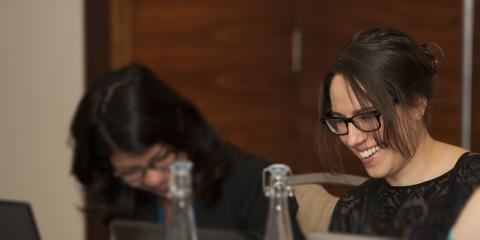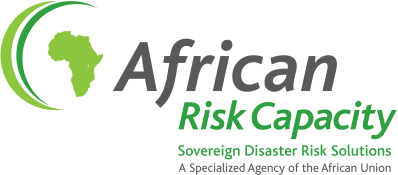
From an idea first outlined in 2006, to a full-fledged institution – with 32 member states, USD 500 million of drought risk transferred, over USD 30 million in insurance payouts triggered and 2.1 million people reached with payouts since starting operations in 2014 – the African Risk Capacity has certainly come a long way.
Dr Joanna Syroka has been there throughout this journey. Starting with just two colleagues and a concept, she developed the underlying analytics and operational processes that made possible ARC’s establishment, then served as ARC’s founding Programme Director managing its operations during its critical first years. Most recently, as ARC’s Director of Research and Development, she led the development of new products such as parametric flood, Outbreak & Epidemic insurance, and the Extreme Climate Facility (XCF). Wearing multiple hats, she has continually forged new paths with endless energy, optimism, and creativity, always looking for efficient and actionable ways to protect the most vulnerable populations in Africa at scale against the impacts of natural disasters.
As ARC continues to lead disaster risk management solutions on the continent, Dr Syroka – better known as Jo – will be watching the evolution of ARC instead of driving it. After nearly nine years with ARC, Jo will be starting a new chapter in her career. In the following interview, she reflects on her time at ARC and hopes for ARC in the future.
Let’s start from the beginning. How did your ARC story start?
The story starts long before ARC. I was working for an energy company in the UK in the then nascent weather risk management market. My PhD had focused on the variability of the crucial Indian summer monsoon, and when I saw a press release from the World Bank in late 2003 that announced it had helped insure 200 farmers against drought in India I thought, “I have to contact these people”.
I started working with the World Bank as a consultant in 2004, first working with Mumbai-based insurance company ICICI Lombard and Hyderabad-based micro-finance institution BASIX on the early transactions that paved the way for the Indian weather insurance market, and then moving on to agricultural weather and commodity risk management projects around the world as different opportunities arose. One of those opportunities was working with the United Nations World Food Programme, WFP.
Richard Wilcox, a Director in WFP’s Business Planning unit at the time, had written a concept note outlining how WFP could use modern financial instruments like weather derivatives and catastrophe bonds to finance its humanitarian responses more efficiently. It sounds like a reasonable suggestion today but it was a totally revolutionary idea at the time. He contacted the team I was working with at the World Bank for help with this idea and the rest, as they say, is history.
I started working with Richard and WFP on what became the first humanitarian weather derivative transaction in Ethiopia in 2006. We wrote a paper in the Journal of International Affairs on how this idea could be scaled to more countries in Africa to capitalise on the natural diversification of weather risk on the continent, but didn’t think much more about it.
In late 2008, the Rockefeller Foundation was speaking with the WFP about innovative projects they could help support and came across our paper. They gave us a seed grant of US $3 million to run with the concept that we had outlined in the Journal of International Affairs – I am eternally grateful to them for taking a chance on an idea. If it wasn’t for the Rockefeller Foundation, there would be no ARC.
In 2009 I started working full-time at WFP on the project with Richard and WFP business analyst, Bronwyn Cousins. Soon Fatima Kassam, who worked with us in Ethiopia, joined the team. ARC veterans Peter Hoefsloot and Federica Carfagna became part of the first technical team working to build out our software, risk models and analytics. We had no idea at the time that what we believed was a WFP project would become ARC. However, when we started talking to the African Union Commission, and with countries that would become our founding member states, we realised the way forward was to design something that would give countries the tools they needed to become the first responders to natural disasters, putting them in the driver’s seat of early, effective response to their vulnerable populations. In 2012, ARC was born.
It’s been an absolute privilege to serve our member states and their vulnerable populations. It’s been an honour to work on something that has gone from an initial idea to a fully developed and operational organization – in fact, two organizations: ARC Agency and ARC Ltd – that has helped change the dialogue on how natural disaster risks can be managed. On top of everything ARC has achieved to date, I’m also incredibly proud of the ARC team that I leave behind and excited for what they will achieve in the future.
What were the biggest milestones for ARC?
Obviously establishing the agency in 2012 and then establishing and capitalising ARC Insurance Company Limited in 2013/14. The first road show when placing our first insurance portfolio in the reinsurance market was a milestone. As someone coming from the private sector, to come to the market with a new programme at scale for Africa and to get commercial support was telling. Of course, this was followed by the first payouts from our inaugural pool due to drought in West Africa in 2014. To see our countries implement their pre-prepared ARC contingency plans with these payouts and have the systems we developed perform was incredible. Despite the payouts our reinsurance support increased for the second pool.
One more milestone comes to mind. The first business case we made to the UK’s Department for International Development, DFID, in 2010 for funding support was hard work, but we were successful and that first DFID contribution allowed us to take ARC to the next level. With each business case comes a set of milestones and targets to be achieved. ARC was classified as a high-risk project. Writing the final report when closing that first contribution a few years later, after having achieved and exceeded all of our initial targets and milestones, was a highly satisfying moment.
How has ARC’s development in the past nine years met or surpassed your expectations when you first started this project?
ARC is changing the way natural disaster risks are managed in Africa, but what I didn’t expect is how quickly it has helped change the dialogue on how these risks should be managed. The ideas Richard outlined in his original concept note were revolutionary. Contrast that to today when considering contingency financing instruments as part of the portfolio of tools for humanitarian response is par for the course. No matter what the future holds for ARC, this success will endure.
From the start I knew ARC was possible, that the weather risks facing millions of vulnerable households in Africa – risks that have happened before and will happen again – could be quantified, indexed and transferred, and I never doubted what we were building with our countries would be a success. I’m just grateful we had the opportunity to do it in the first place.
In your view and in your work, what were some of the largest challenges ARC has overcome? How has the project grown stronger from it? What are the lessons learned?
When you do something for the first time, when you have no playbook to follow, you will always find things you could have done differently. That’s normal and what’s important is to learn from those lessons and improve. By design we created a strong discussion, review and feedback loop with our countries – not just in terms of customisable products but also on the overall country engagement process – which helped us quickly identify what we needed to be adjusted in ARC’s processes and parameters to increase effectiveness. Like with any business, it’s a constant learning process, but I believe this close interaction with its countries will continue to make ARC a stronger institution and the products it offers its member states more meaningful.
At the end of the day ARC is tackling a big problem. The challenges facing the humanitarian system and African countries can be daunting and complex. It’s easy to be overwhelmed, but you need start somewhere. With ARC, we first focused on the technical underpinnings of a pool – developing our Africa RiskView software to support a parametric drought insurance product and to calculate potential risk pool savings. That gave us something tangible to talk about with countries, partners and donors to bring them on board and moreover it gave us actual transactions to aim for. The rest of ARC grew from there. With its infrastructure and track record now in place, ARC is in a position where it can start thinking about new ground-breaking initiatives – like XCF, Replica Coverage, and Outbreaks & Epidemics – and is forging new partnerships that will offer more comprehensive risk management opportunities to its member states. That wouldn’t have been possible had we tried to do it all from the outset and not started with one simple flagship product and program.
Personally, what was your most memorable moment with ARC?
The moment I most remember was the first ARC Ltd board meeting in London in January 2014. The company was about to be capitalised with the first insurance pool soon to be launched and placed in the market. It proved that all these ideas we had been working on with our countries and partners were not only actionable, but were about to become real.
Where do you hope to see ARC in the next five years?
Through ARC, Africa has led the way in innovative risk finance and I hope it continues to do so. In addition to growing the drought insurance pool with more member states, I look forward to seeing ARC launch the slated products we have been working on in R&D, including parametric flood and tropical cyclone coverage, XCF, as well as the Outbreak & Epidemic insurance programme. With its unique position as a member state organisation, ARC can run with these ground-breaking initiatives and continue to transform how risks are quantified and managed on the continent and beyond.





